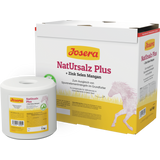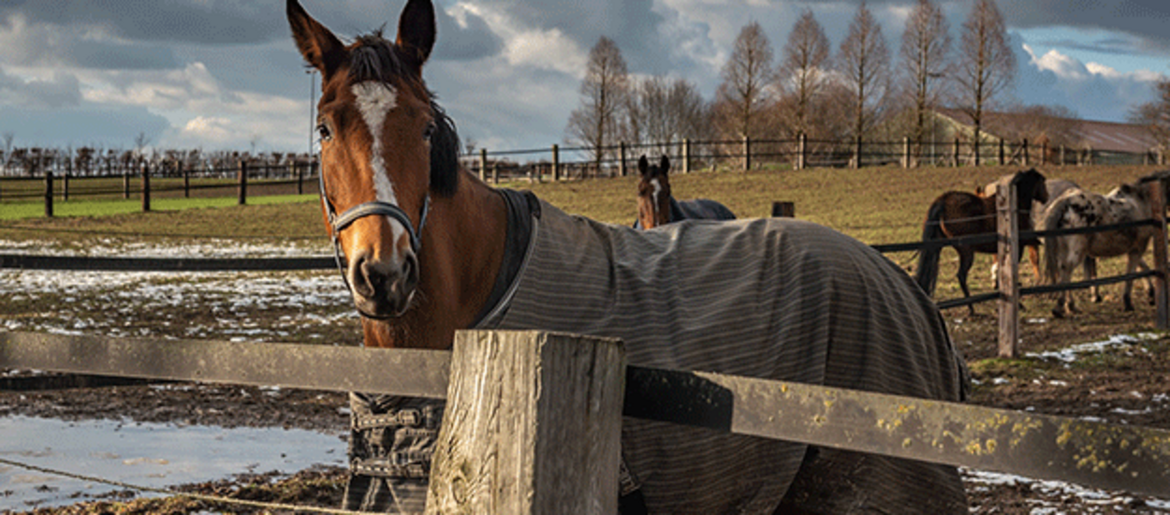Should I wrap up my horse?
When the days get longer and temperatures are getting closer and closer to zero, many horse owners wonder whether they should 'stock up' their horse or not.
The short answer to all of these questions is: It depends. There are a variety of factors that influence these decisions. Basically, it can be stated that the main factor is the type of housing.
It depends on the type of husbandry
The type of housing is the most important factor. Do you keep the horse with a naturally developed winter coat or do you use a blanket as protection from low temperatures? Horses that are always in the paddock put on a thick winter coat, so they are well protected from all possible freak weather. As they are used to temperature fluctuations, they can do without a blanket.
If a long winter coat is undesirable or if your horse is clipped anyway, a blanket is mandatory.
If the horse is kept in the stable, it depends on the temperature of the stable and on the equipment that you use for your horse when it leaves the stable. In principle, it is better to cover the horse in stables where there is a draft.
It is most complicated when there are big fluctuations between the stable and the field. It is warm in the stable, the paddock can be very cold. Horses so often have problems adjusting to the changing temperatures with the right coat thickness. A blanket is a good idea at night, but it would have to be removed during the day, otherwise the horse will sweat and run the risk of getting cold.
What to do during training
If the horse sweats, moisture can accrue between the coat and the rug. This undermines the protective effect of the coat, because it protects against moisture from the outside. The sweat that is directly on the skin quickly leads to hypothermia. In addition, it takes a long time for the fur to dry again. During all this time, the risk of catching a cold is high, because water and moisture conduct heat and cold very well.
Horses that are ridden or trained regularly should therefore always be covered. The more training the horse has to complete, the sooner it should be covered or sheared.
The golden rule
The cardinal rule is that horses do not have to be covered if they are protected, dry and have formed enough winter coat. However, if your horse does not have enough winter coat (this can be the case due to early covering, clipping or keeping in a warm stable), covering is mandatory.
The worst thing for horses is a combination of cold, wet and wind. In this case, your horse should always be covered.
The decision must always be made individually, depending on the horse, type of posture and training program.
Excursus: My horse is shaking - is it cold?
Basically, horses feel just as comfortable at thirty degrees as at double-digit minus temperatures. When a horse is shivering at low temperatures it is trying to "shiver warm". In healthy horses, such acute tremors only last a very short time and are then replaced by internal heat production. (The large intestine of horses is a kind of built-in heater that converts 30 percent of the roughage ingested into heat.) However, if the horse trembles for longer or more often, a veterinarian should always be consulted to be on the safe side.
Tip for checking whether the horse is cold: If the base of the ears are warm, everything should be ok. A cold set of ears, on the other hand, is often a sign that the horse is too cold. Then something should be done.
Horse blankets
Opinions on horse rugs sometimes differ. There are people who don't believe in their use at all. Basically, horse rugs will not harm a horse if used correctly. It is true, however, that such blankets are often not necessary.
The following points should be avoided so that horse rugs are used correctly:
- Bad fit
- Abrasive blanket
- Use a horse blanket instead of warming up before riding
- Use a sweat rug instead of dry riding
- Use of the wrong blanket for the current weather (e.g. sweat blanket when it rains)
- Horse is covered too warm
- Horse is covered irregularly, which is bad for thermoregulation
Rug types
There are different types of horse blankets. Here are a few types and what they are used for:
- Cooler: Used to keep the horse warm and dry after work.
- Transitional ceilings: for low temperatures that are still in the plus range.
- Winter blankets: in frosty temperatures. High-quality blankets protect up to - 25 degrees.
Always remember to watch how the horse reacts to the blanket. How is it coping with that?
Basically horses are amazingly insensitive to cold. Changing temperatures and climatic stimuli also have a positive effect on the horse's health and immune system because it hardens. Horse rugs are often not necessary, but it's good to have them ready in an emergency.
Latest reviews
-
 4.8 (4)
4.8 (4)Starhorse Biotin Plus, 550 g
-10%- Biotin, Zinc & Methionine
- Slightly sweet taste
- With vanilla flavour
€ 26,95 € 29,99 (€ 49,00 / kg)Delivery by April 17
-
 4.0 (1)
4.0 (1)Josera NatUrsalz Plus - Horse Lick, 5 kg
-10%- Can be used in organic farming
- Salt lick with zinc, selenium & manganese
- High acceptance
€ 6,74 € 7,49 (€ 1,35 / kg)Delivery by April 17
-
 4.6 (71)
4.6 (71)GladiatorPLUS Gladiator Plus Horse, 1.000 ml
- Excellent ingredients
- High bioavailability
- Sugar-free
€ 91,99 (€ 91,99 / l)Delivery by April 17
-
 3.7 (3)
3.7 (3)leovet Milton White "Grey Shimmer", 550 ml
-10%- Fights discolouration
- Brilliant white effect
- Made with natural proteins
€ 15,25 € 16,99 (€ 27,73 / l)Delivery by April 17
